|
Cambridge Soundworks 210D (Page 2/5)
|

Posted: September 6th, 2002
Written by: Justin "The Sheriff" Woods
Inital Impressions & details
| My initial impressions of the 210Ds were positive as I pulled everything out of the massive box. Cambridge does a good job to ensure that the speakers don't get damaged during shipping. Every component was securely surrounded by packing foam. The first thing you see as you open the box is the sub-woofer. The best way to get the speakers out is to turn the box upside down, open it, then gently turn it over and pull the box off of its contents. The two 60 watt satellite speakers are from Cambridge's Newton series, which boasts prices upwards of $5000.00. The Asymmetrically curved satellite cabinets all but eliminate distortion-causing reflections known as "standing waves." Simply put, a standing wave is a point in a concert hall or room where similar sound waves move in opposite directions and cancel each other out, creating a dead spot. |
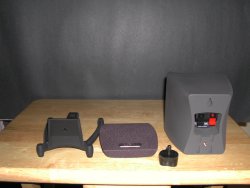
Click to enlarge
|
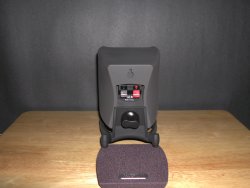
Click to enlarge
|
| Another point to mention is that the satellites are slightly bigger than anything preceding them. Combining this larger design with the smaller but more powerful Neodymium-magnet motor structure, air space inside the speaker cabinet is dramatically increased. More air space means deeper frequency response. The satellites come mounted on a small stand, which can be removed by unscrewing the small thumbscrew on the back. Included in the packaging are small self-adhesive feet that stick to the bottom or back of the speaker (for wall mounting). I chose to leave them on the stands, as I like the way they look. Of course, also included in the box is a set of wall-mount screws, which are easy to install. The satellites can also be mounted to the wall using a swivel-bracket or on a floor-stand, which elevates them above the floor about two feet. Neither of these mounting options are included with the 210Ds, but can be bought from hifi.com. |
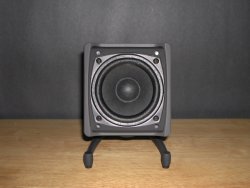
Click to enlarge
|
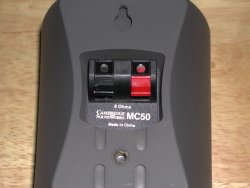
Click to enlarge
|
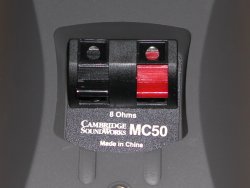
Click to enlarge |
| As you can see from the photos, the satellites connect to the sub-woofer using standard speaker cable. The cable is marked at each end with a small red ring to ensure that both ends of the cable are connected correctly. If you cross cables, you'll end up with speakers that are out of "phase", which lowers bass response, and can create a muddy sound. When speakers are in "phase" the speaker cones (known as "drivers") move in and out together, which is what you want, as it produces the best sound. Also noted in the pictures is that the satellites are 8 Ohm. Ohm is a measure of resistance, so the lower the number the better. |
Next Page - The Amplified Subwoofer
|



